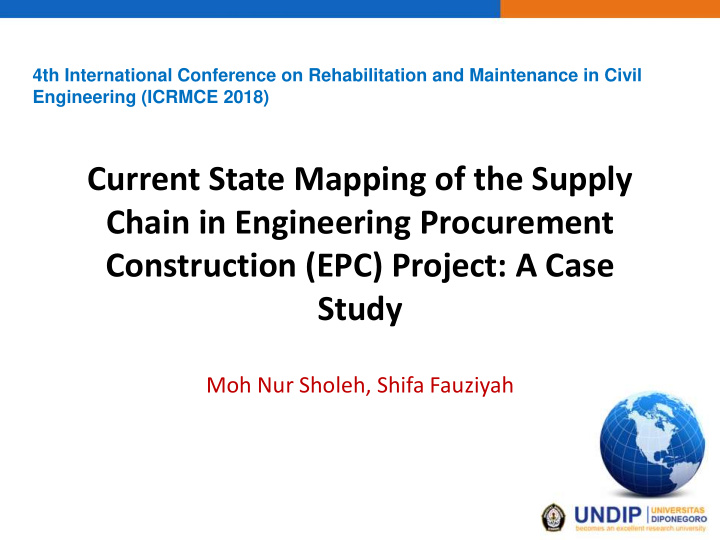



4th International Conference on Rehabilitation and Maintenance in Civil Engineering (ICRMCE 2018) Current State Mapping of the Supply Chain in Engineering Procurement Construction (EPC) Project: A Case Study Moh Nur Sholeh, Shifa Fauziyah
Introduction • For a long period of time, the poor performance and poor efficiency in construction projects have been confusing the researchers and stakeholders. • Supply Chain Management (SCM) that has been successfully applied in manufacturing is introduced to construction projects to improve efficiency and reduce waste. • Therefore, the construction project competition among companies has been changed into the competition among supply chains
Introduction • One of the biggest project in Indonesia is Engineering Procurement (EPC) project at Banyu Urip, East Java. • In the EPC projects, general contractors including designer, material procurement, construction, and operators. • General contractors faced bigger risks than conventional projects, so SCM becomes an important aspect for the general contractor. • This is because EPC projects characteristically have long processes, large scales, and multi-supplier. So, how the general contractor can maintain supply chain performance. • Thus, there is a need for research to explore the current state mapping of EPC projects.
The Objective of Study • The problem that usually occurs at EPC project is a type of material that is unique and large as the pipe of oil refining. • For example, the EPC project of this case study used imported material. • The contractor should plan where to buy it, when to bring in, and how good process of delivery is because they are the key success of the supply chain. THE OBJECTIVE: To map the supply chain Engineering Procurement Construction (EPC) project • • Use Value Stream Mapping It will illustrated in the (VSM) method to explain the procurement process procurement processes for behavior within a specific easier understanding and period from the total problem identification. production time.
Methodology Questioannaires : Method : Interviews : - Production lead + The flow of EPC time procurement - Processing time Data - Fill the questionnaire Face to face collection: - Collect the data Quantitative analysis Qualitative analysis Data with Value Stream from interview Analysis: Mapping (VSM) method Case study: the procurement of pipe material
Results & Discussions • Banyu Urip project consisted of 5 major contractual divisions of work to Engineer, Procure and Construct (EPC) the facilities needed to produce the field. • These divisions were called EPC-1 through EPC-5 → This study focused on EPC-1. EPC-1: EPC-2: Central Processing Facility Onshore Pipeline EPC-3 EPC-5 EPC-4 Offshore Pipeline, Mooring Infrastructure, Raw Water Basin and Gagak Rimang floating storage and Tower and Support Structure Flyover Road offloading vessel
Results & Discussions • The EPC-1 contract was awarded to Indonesian-led consortium Tripatra- Samsung, whose scope included the Central Processing Facility (CPF), which was built logistically central to Well pads A, B and C, where 45 wells were drilled to produce the crude oil and inject water and gas. • Natural gas, produced along with the crude oil, is used for power generation at the CPF. • This is gathered with flow lines and processed by the separation equipment to remove gas and water components from the crude before its delivery through the pipeline for storage and sale. • At peak construction, over 17,000 people worked on Banyu Urip EPC-1 project simultaneously.
Results & Discussions Supply chain of pipe supports in EPC Project
Performed by Engineering Performed by Field Engineering 1 week 3 weeks 3 weeks Vendor Owner Send back Material Damage / Non conformance Material Send Approved Receiving Checking Material – Material – Total time: Material Create Send to Vendor Create Material Material Construction 21 weeks Issurance Slip Receiving Phase Report Request Purchasing Field Engineering Send Request Confirm the Specification Send to Purchasing automatically Share/upload Create Approved Pipe Pipe Create pipe modeling Modeling Modeling Material MRS Purchase data on Requisition (3D Autocad Checking Order (PO) Material Sheet (MRS) & Ansys Tracking Program) System (MTS) 2 weeks 2 weeks 2 weeks 3 weeks 2 weeks 3 weeks Current state value stream mapping of pipe material
Discussions • The procurement of pipe that needs 21 weeks to flow through the phase completely is too long. • The contractor should be able to accelerate the time again. Improve communication Use local vendors during Involving suppliers early in and coordination between the EPC project in the case the design and develop supply chain participants. study often takes the supplier alliance. With the Effective communication overseas vendor, especially large scale of the project between different the pipes material. It is and all is designed by departments in-house is a rather difficult but with a contractor, it is necessary to common difficulty for good cooperation of local involve other parties in the engineering firms. Industry vendors and good quality of design phase. Suppliers will practitioners explained materials, this concept can direct understanding of the that 15% of engineering reduce the duration of project requirements early designs have some procurement of pipes and be able to manage their mistakes. material. own supply chain better.
Conclusions • This paper has illustrated some of the complexities presented in construction supply chain by presenting the case of pipe supports used in EPC project. • It also has demonstrated the current state mapping that is very valuable to improve the supply chain performance in EPC projects. • Based on a case study on pipe material, the procurement process from upstream to downstream takes 21 weeks. This is a waste of time to look for solutions. • There are some views of supply chain improvement that need to be applied and certainly still need a lot of studies. Such views are (1) using the local vendors, (2) involving suppliers early and providing input into engineering design, and (3) making good communication between supply chain participants.
Thank You Moh Nur Sholeh mohnursholeh@live.undip.ac.id
Recommend
More recommend